Paper 1 and 3 Research methods and methods in context
1/38
There's no tags or description
Looks like no tags are added yet.
Name | Mastery | Learn | Test | Matching | Spaced |
|---|
No study sessions yet.
39 Terms
Ethical issues in research methods
informed consent
Confidentiality
Types of interview
unstructured
structured
Strengths of observations
Limitations of questionaires
lack of subjectivity, limitation of questionnaires (imposition problem)
low return/response rate
Positivism and Interpretivism
Theoretical perspectives
positivism: sociology should be treated as a science, objectivity and value freedom ( no bias/prejudice from researchers in conduction of research)should be reinforced, reliability emphasis- replication and repetition- Popper falsification, representative sampling methods= generalization of results, data usually quantitative in nature, objective, structured scandalized procedures into research= repetition and reliability
Interpretivism: subjective in nature, value laden- researchers own ideas/meanings brought in to understand behaviours
value laden= verstehen=putting yourself in another persons shoes, empathy to learn behaviours, understanding individuals world view at a finite level
qualitative data usually, emotions/thoughts/feelings of individual taken into account and recorded throughout
everything unstructured in nature usually, to gain deeper insight into individuals
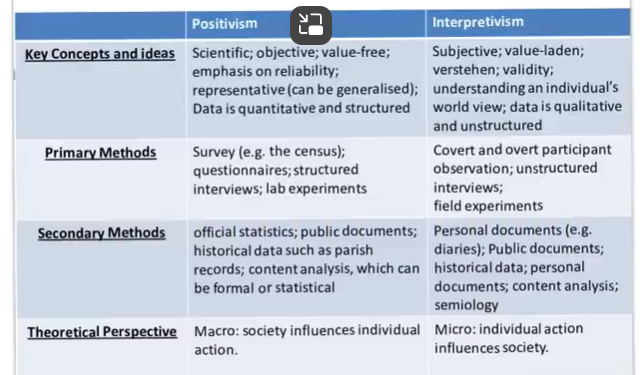
Structured interviews
researcher will go in with pre-coded questions
cant probe any deeper into response, easier reliability
Lab experiments:
all variables are controlled, standardised
for reliability
Secondary methods- positivsm
historical data- gives snapshot of data at the tipe
formal content analysis- allows for quantities data to be generated, standardised, classification created, themes generated- trends recognised
Interpetivism
-hidden meanings in naturalistic settings
methological pluralism
the practice of using multiple, diverse research methods and perspectives to address a research question. It's about recognizing that no single method is inherently superior and that different methods offer unique insights and strengths.
multi-method approach
verhesden
Max Weber introduced Verstehen as a methodological approach to gain a deep understanding of social actions by interpreting the meanings individuals attach to their behaviors. This approach contrasts with purely objective or quantitative methods, highlighting the importance of empathy and perspective-taking in social research.
PET
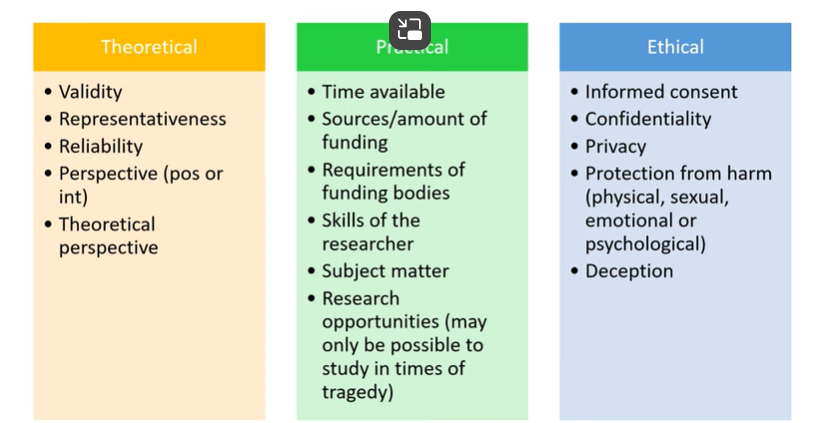
Going native
criminal behaviour conundrum
Cheat sheet for the PET model

field experiments
Research methods
Preferred by positivists:
social surveys
structured interviews
experiments
official statistics
Preferred by interpretivists:
unstructured interviews
personal documents
participant observations
Both
non-participant observation
^ positivists see this as more favourable to participant observation, because non-participant observation aligns with positivist principles of objectivity, data collection, and scientific rigor. Positivists see it as a way to observe behaviour and collect structured data, which can then be turned into quantifiable information
interpretivists see non-participant observation as a valuable tool for understanding social phenomena by observing behavior without direct interaction, potentially gaining insights into "actual behavior"
Though acknowledge the limitations of this approach, including the researcher's inability to fully grasp the meanings and interpretations behind the observed behavior.

criticism of volunteer sampling
Vanketesh Gang Leader for a Day 2009
Venkatesh spent around 7 years in his study, producing a vivid description of the lives and relationships of the black residents, gang members
overt participant observation
access; his South Asian ethnic background allowed him to pass amongst the African-American subjects of his study
questions on data reliability and validity:
He was able to capture the spirit of various conversations, though issues with reliability
Practical challenges: The long term immersion required significant personal and financial resources, highlighting the practical demands of ethnographic research
Positivism vs Interpretivism

Consensus, conflict and social action theories
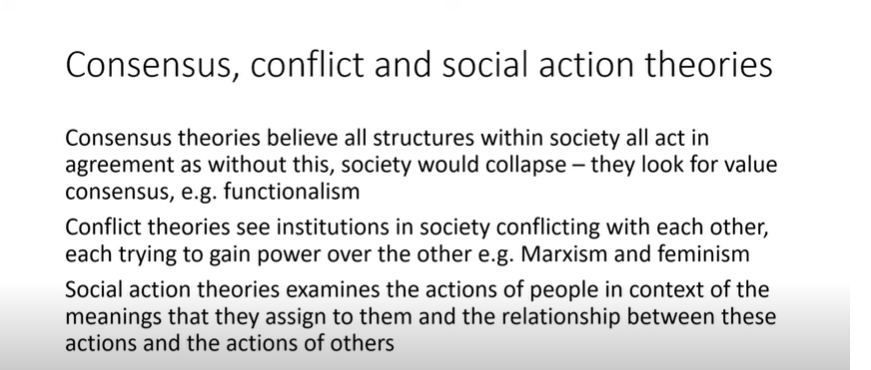
Modernity and post modernity
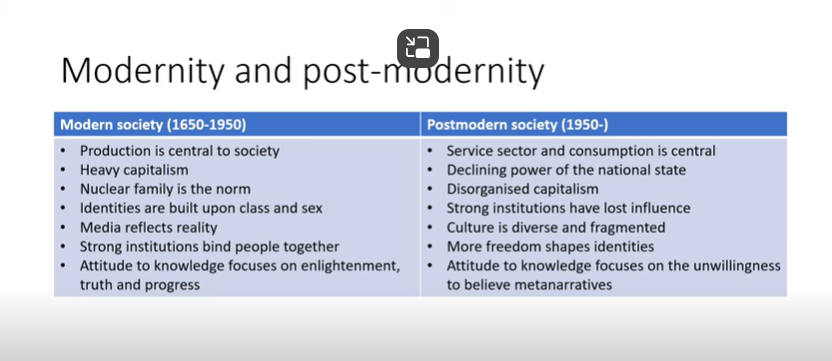
Black eyed Blue eyed experiment
Is sociology a science
Popper and Kuhn and postmodernists= lean towards no
Realists= more towards yes

The relationship between theories and methods

Subjectivity and Objectivity
Subjectivity- usually associated with feminists and interpretivists
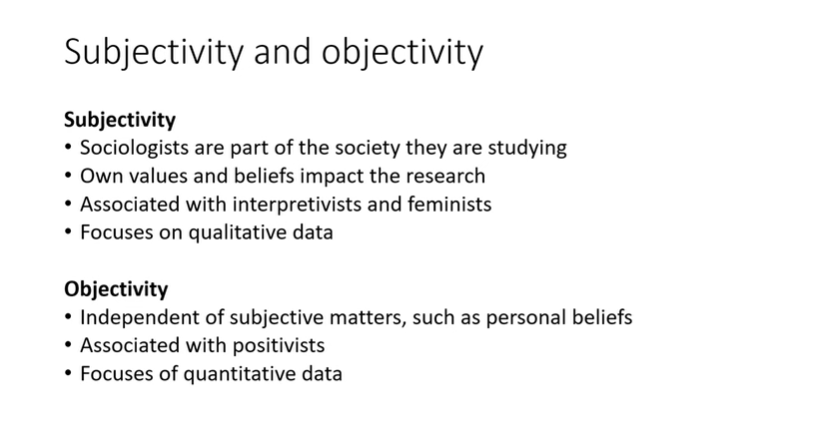
Can sociology be value free?
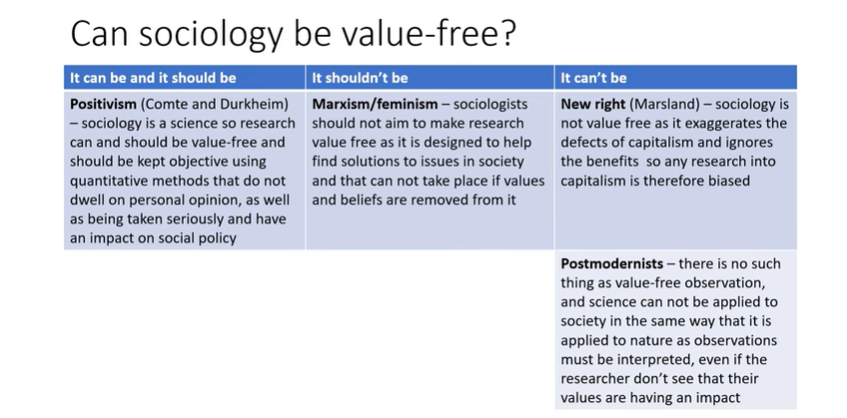
Sociology and social Policy
*1997 conservative government
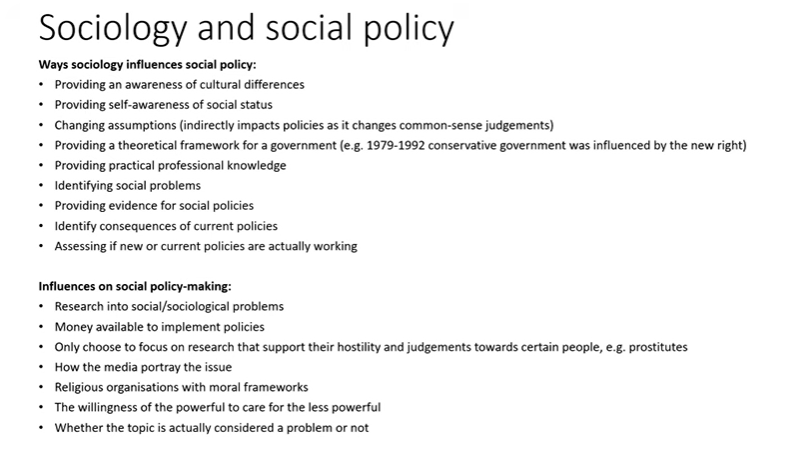
Perspective on social policies
*Marxists dont like social policy:Marxists may agree with the goal of social policy to address inequalities, they generally critique the effectiveness of these policies within a capitalist system. They argue that social policies are ultimately used to maintain the capitalist system and may not address the root causes of inequality, which they see as inherent in the system itself.

Official Statistics
Divorce Rate
Birth rate/death rate- hard statistic
Infant mortality rate
Marriage rate
GCSE/A level results
Crime Rate- soft statistic- more opt in not everything will be recorded, dark level of crime
measuring trends and patterns, whether things are increasing or decreasing
Documents
Diaries- E.G Anne Franks letters
Letters- Thomas and Znaniecki, Polish Peasent in Europe and America
Paintings- Aries pictures of childhood
School documents- Gillborn- used school policy documents on racism, local authority guidelines into racism to get an official picture of what was happening in schools, he could then use them to compare to interviews and observations
Gerwirtz- Other school documents include marketization documents such as school prospectuses/websites, about how schools present themselves + positive thee documents all free
Observations
Covert
‘Black like me’ Griffin
changed skin colour to experience racism in the deep south
Humphreys ‘Tea room trade’
researched gay activity in men’s toilets
Overt
Observations- Lacey
Ofted- causes hawthorn effect
Semi-overt
Punch Amsterdam police- he was told that we only show you what we want you to see
issue of ‘going native’, getting too involved
Questionnaires
Connor and Dewson- Decision of W/C students to go to university
sent 4000 questionnaires to students in higher education institutions to uncover the factors that influenced the decisions of working class students to go to university (large sample size) its representative
evaluation: however as found in Shere Hite’s piece of research on love, passion, and emotional violence, the response rate was pretty low 4.5 percent returned out of the 100,000 questionnaires that were sent out
^criticized for sampling methods as being non- random and biased
Interviews
Structured interviews
Willmott and Young- high response rate, out of 987 approached only 54 refused in their study into the extended families in East London and they were able to train interviewers as the interview was fixed and standardised
concern: however this will limit the data collected
Semi-structured
cicourel- used follow up questions eg: what do you mean?
unstructured
Oakley- method favoured by feminists such as Oakley into her study on motherhood
unconventional method even included her being at the birth of some of the babies
Group
Willis- educational context
used group interviews in his research of working class lads to uncover their experience of school and the transition into the workplace
Experiments
Field experiment
Rosenthal and Jacobson; Brown and Gay
repeated over 250 times
Used two actors one was black and one was white with exactly the same qualifications, age and gender, race the only difference
approached job interviews to uncover racism
criticism: cant be sure all variables were accounted for, lab experiment may be more preferable
Lab experiment
Milgram- Obedience study 1963
wanted to understand why ordinary people obey authority figures, even when it involved haring others- inspired by Nazi behaviour WW2
Strengths:
High control over variables = more reliable results.
Can establish cause and effect (obedience caused by presence of authority figure).
Replicable – other versions of the study confirmed findings.
Weaknesses:
Low ecological validity – artificial situation.
Ethical issues – deception, psychological harm, lack of informed consent.
Sample bias – only American males = lacks generalizability.
Thought/comparative study of suicide
Durkheim- suicide research
Milgram experiment further details
Participants thought they were in a memory/learning study.
A confederate (the learner) was placed in another room.
The real participant (the teacher) was instructed to give electric shocks (fake, but believed to be real) to the learner for wrong answers.
Shocks increased by 15 volts up to 450 volts.
An authority figure (experimenter) in a white lab coat gave prods like:
“Please continue.”
“The experiment requires you to continue.”
🧍♂ Sample:
40 male participants (aged 20–50), recruited via a newspaper ad.
All from the New Haven area in the U.S.
📈 Findings:
65% of participants obeyed fully, administering the full 450 volts.
All participants went to at least 300 volts.
Many showed signs of distress (sweating, shaking, nervous laughter).
Whyte’s “Street Comer Society”
James Patrick’s “Glasgow Gang Observed
Access: James Patrick was invited into the gang to observe by the leader, however for other researchers, this is often a limitation as they tend to have to earn their way in rather than it being given
Cost; it was cheap as Patrick did all of the observation himself, he didn’t hire anyone
Going Native an issue- he immersed himself in the lives of the gang
Practical limitations of covert participant observation:
Time-consuming: Patrick spent 120 hours undercover to immerse himself in the gang
Recording- as the majority of the gang didn’t know his true identity, Patrick couldn’t record his experiences, it had to be from memory could’ve been obscured from drugs, drink etc- affects validity
Controlling variables- he couldn’t control the way people acted and couldn’t ask many specific questions as gang-members may have gotten suspicious
Ethical strengths
Confidentiality- Patrick even published under a false name as well as giving all the gang members fake names to protect them
James Patrick’s “Glasgow Gang Observed pt 2
Ethical limitations;
Informed consent- the gang members never gave permission to be watched as they didn’t know
Vulnerability of respondent; Patrick cpuldn’t step in to help any of the gang members if they were in danger with fighting etc
Danger: he had to carry weapons, take drugs, drink heavily
Issues with reliability
The observation was low in reliability because it was not able to be repeated and therefore can’t be compared
Sampling
Evidence:
Wilmott and Young- in their Bethnal Green study, used every 36th name on the electoral register
Opportunity- Patrick ‘Glasgow gang’ James Patrick, sample the gang he had access to at the time, looked young so could fit in
^covert observation